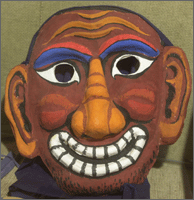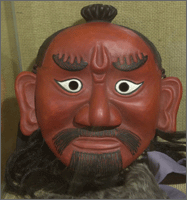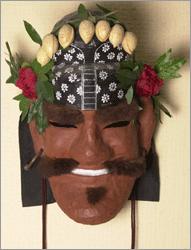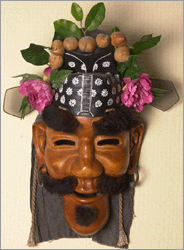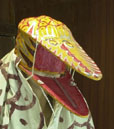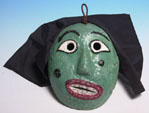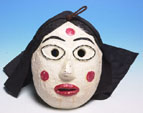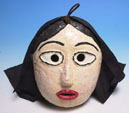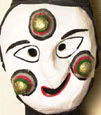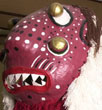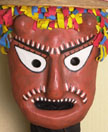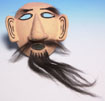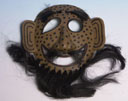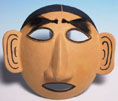 |
 |
|
Bangsangssi (Major traditional material No. 16)
Bangsangssi is a tal (Korean mask) with four eyes. It was used for a funeral service and according to the book, <Munheunbigo>, Bangsangssi, the mask with four golden eyes, was worn on the funeral day. The Bangsangssi tal was originally used for exorcising an evil sprit in funeral custom since the ancient Chinese Ju country. In Korea, the records indicate that it was used for funeral service and exorcising ceremonies from the Shilla Dynasty in 5th ? 6th century until the Chosun Dynasty. The surviving Bangsangssi was found with other funeral stuffs in storage at Changduk palace in the 1970s. Bangsangssi was used for exorcising purpose in a king’s visit or at a welcoming reception for a Chinese envoy. However, the use was gradually changed to exorcising an evil sprit living in Kwangjoong (a dent where corpses were buried) and it was placed in front of a funeral bier. Bangsangssi was buried near the grave or burnt down after each use, so a new one was produced for every funeral service. The materials used to produce Bangsangssi were wood, paper, straw and bear skin. Bangsangssi had two to four golden eyes and wore red upper clothes and a black skirt with spear and a shield held in its hands. Bangsangssi made of wood was used for the government or powerful gentry, those made of paper for general noble class and those made of straw for common people.
Bookchung Saja Noleum (Bookchung Lion Play: Major intangible cultural asset No. 15)
It is a mask play passed down in Bookchung region of Hamkyungnam
province. The play came with unique music called Aewonsung. As
for the form of the play, a noble man had his servant sing and
dance including Kal chum (knife dance), Sadangkeusa chum (depraved
monk dance), Kkopsae chum (hunchback dance) and Moodong chum (a
child dancers dance). The lion play was performed in many areas
of Hamkyung province such as Bookchung, myungchun, sungjin, hwoiryung,
keumsung, hamjoo and yungheung, and the lion play at Bookchung
was the most popular among them. As the lion was an animal living
in central Asian countries, the lion play also came from those
countries. The lion play was referred to as Sanye in <Hyangyakjapyoung>
written by Choi, chi-won and <Samkooksaki> (a history book
about the three country era) recorded that Mokwoosaja (the lion
statue raising a cow) was used when the general named Leesaboo
conquered Woosan county. Considering twelve songs written by the
musician named Wooreuk included Sajaki (lion), the lion play can
be inferred to have been performed since the Shilla Dynasty. The
lion, as a wild animal, was believed to have the ability to prevent
bad luck and bring good luck, so it was frequently performed.
Bongsan tal chum (Bongsan mask dance) is one of the mask dances
passed down in Haeseo region in Hwanghae province. The Bongsan
mask dance was performed at kyoungsoodae located in Bongsan town
and later under the Sariwon Kyungam Mountain after administrative
organizations moved to Sariwon around 1915 and the Kyungeui train
route was opened. The Bongsan mask dance was also played once
yearly at the markets that took place every five days in Hwanghae
province because merchants called the mask dancers and asked them
to perform. Haeseo mask dance was very popular especially in Hangjoo,
bongsan, seoheung, and pyungsan as they were important markets
along the direct South-North road connecting Palyeukji. The major
eups (towns) in the Hwanghae province during the Chosun Dynasty
were trading posts of agricultural and hand-made products and
economically rich enough to support the mask dance performance.
The biggest play has been performed on the traditional holiday
called Dan-O in May since the Chosun Dynasty.
Choyong-tal (Choyong's dance: Important intangible cultural asset No. 39)
Dancers danced with the mask and repeled bad spirits in court functions and an annual ceremony. According to the literature, Choyongrang-manghaesa(Choyong; Choyong, ,Manghaesa; watching the sea temple) in Samgukyousa #2 (a history book about three separate countries in Korean peninsula between 4th C~6th C), it says that Choyong was a legendary person in king Hongang, a 49th king (875~886) of the Silla dynasty. The great king played in Gaewunpo(clouds go away harbor) and lost his way due to sudden clouds and fog. The king felt strange and asked his vassals. Then, one said, “This is East Sea Dragon (as a god)'s trick, your Majesty must do good for him to make him happy. Thereupon, the king ordered the government official to build a temple there. Then, the clouds and fog disappeared and they called the place Gaewunpo (fog cleared away port). The East Sea Dragon was very delighted and brought his seven sons in front of the king to admire his virtue so, they danced and played music. In return, Choyong, one of Sea Dagon’s sons followed king Hungang to Seoul and helped his work. The king gave him a beautiful woman as a wife and a government position, Gupgan. When time passed by, one day, because Choyong's wife was so beautiful, an evil sprit adored her so much and turned into a human shape to stay secretly in Choyong's house. Meanwhile, Choyong came back home to see that the two people were together and he started singing about the situation and stepped back from the house.
The song was like this:
“With the bright moon in the east, after playing all night, I come back and see that there are four legs in my bed, two sure are mine but whose are the other two, originally it was my wife, what can I do after being stolen?” Then, the sprit turned back to the original feature, kneeled down in front of Choyong and said, “My Lord, I made a mistake because I fell in love with your wife, but you didn't get angry, I'm so much impressed by your virtue. Upon my oath, I'll never go inside the door which has your face figure.”
There is a detail record about Choyong'dance with Choyong's face
figure, Choyong's style of dress and making Choyong'mask in 'Akhakgoibum(18C's
music book)' in the 9th king Sungjong(1457~1494) of Chosun dynasty(14~20C).
Official hats are made with nets of bamboo and usual, paste papers
and paint flowers. Masks are made using carved lime trees or lacqued
cloth for the exterior, painting them, hanging lead beads and
tartar rings on both ears. They used delicate ramie fabric to
make peony blossoms and peach tree branches, ground trees for
peaches. While Choyong's tale had been transmitted as an incantatory
tradition with an actual belief in their daily life as a deep-rooted
faith, the figure of Choyong's mask was held up as a faithful
symbol and transformed from an exorcism to musical entertainment.
Hahoe ByulShin Gut (Important intangible cultural properties)
Hahoe Exorcism for the Unusual Gods is a sacrificial ritual to wish for welfare and abundant harvests for villages. Key roles are played by the half brothers of different surnames in Hahoe village, Pungsan town, Andong county of the northern KyungSang province(presently Hahoe village, Poongchon town, Andong country, KyungSang province). Among others, masquerade is an act of the god of pleasure to entertain the tutelary deity. Exorcism for different gods was executed once every 3, 5, or 10 years, when the oracle (sort of an apocalypse) of a tutelary deity of the 5th binary term of the sexagenary cycle was received, or when the villagers shared the same opinion(that it was time for exorcism). The exorcism started like this from the first day of January based on the lunar calendar was enjoyed till the 15th of January. First of all, the captain of the village prepares a pole and a rod to be possessed by the tutelary deity after choosing a carpenter who has no impurity. On the morning of the second day of January, the captain, the shaman and the clowns gather at the shrine and set up the sacrificial offerings, put up a 4-5 meter-long pole and a rod of about 1 meter, and get into trance. Fabrics of 5 different colors are hung on the pole, and a bell is put up on top. If the bell rings, it is thought to be possessed by a spirit, and the bell is moved to be hung on the pole. Then the pole is lifted up and passed through the shrine of national policy and the shrine of three gods governing childbirth, and was held up in the courtyard of a previous town shrine and the masquerade began.
Details of Masquerade In the first courtyard, a bride dances, sitting down on other's shoulders. In the second courtyard, a couple of head priests dance to drive out the demons and evil spirits and purify the atmosphere. In the third courtyard, a butcher strikes down a bull and pulls out his heart and genitals and pokes fun at the spectators with humorous banter, satirizes the authoritarianism of the ruling class who suppressed feelings toward sexuality, and incites laughter from the spectators by freeing them of the daily taboo. The fourth courtyard is that of an old woman, who became a widow at the age of 15, and she sings a ballad of her lot through a song of a loom. In the fifth courtyard of a depraved monk, the monk dances and plays with a lady and runs off, carrying her on his back when a servant finds out. In the sixth courtyard of an aristocrat and a scholar, a love triangle of an aristocrat and a scholar with a lady is expressed comically. In such a manner, the town's captain and adults, without impurity, participates to perform sacrificial rites on the 15th of January based on the lunar calendar. The masks are kept in the shrine again after the rites and a 'marriage ceremony ritual' and 'bridal room ritual' are done, and the clowns disperse. Afterwards, the shaman performs the conclusive Heochon Street ritual to get rid of all the demons and evil spirits that have been stuck in during the exorcism of unusual gods and the whole ritual ends.
Hahoe Mask (National Treasure No.121)
Hahoe mask is our precious cultural inheritance which has been solely appointed as a national treasure(No. 121, including two of Byungsan masks) among other masks in our country, and is evaluated as a world-wide masterpiece in the mask art division. It is said that Hahoe masks used to consist of 14 kinds, two of head monks, a bride, an aristocrat, a scholar, a monk, a butcher, a servant, an old widow, a fool, a lady, a bachelor, an outhouse, and a hulk. However, the outhouse, bachelor and hulk masks got lost somehow since no one knows exactly from when and why they are not handed down. Hahoe masks are superior to other masks in their realistically formative beauty and their functions. Especially, the nobleman, scholar, monk, and the butcher masks have separate chins and function just like a human jaw structure that enables the realistic sense of real mouth figure when having a conversation, which is a unique characteristic that can't be observed in other masks. For instance, if the clown behind the mask leans backward to laugh, the mask presents a smiling face with a wide-open mouth, and if he bends down his head when angry, the mask has a shut mouth, angry expression with the chin and the upper lips compressed together. As supporting this, a saying "A mask is sacred: if the clown in the mask smiles, the mask smiles too, and if the clown gets angry, the mask shares the anger, too." is passed on. Among others, the mask of the Fool, especially, has no chin. Due to this fact, the following tale is passed on as a legend. "Once upon a time, a young man named Huh in a village started making a mask after an oracle from the tutelary deity has been received. He was making the mask with the utmost devotion, had golden string tied up so that others cannot come in and out, and performed his ablutions daily. By the way, a young woman who adored Huh very much could not stand her desire to take a peek at him, and one day broke the taboo, went over the golden string and stole a glance inside the camp. Huh, having been whittling a mask in a state of divineness, collapsed spitting blood and died. With such a reason, the mask of the Fool, which Huh was whittling as the last piece, could not be finished properly and was handed down without the chin." The wood materials used in making the Hahoe masks are all alders,
and the manufacturing period is estimated as the middle of Koryo
Dynasty. Hahoe masks have been stored in the Hahoe village and
have been appointed as a national treasure in 1964 and presently
possessed by the National Central Museum.
Byungsan Mask (National Treasure No.121)
It is a mask used in masquerading in Byungsan village, Pungsan town, Andong county of the northern Kyungsang province(presently: Byungsan village, Pungchon town, Andong city of northern Kyungsang province). Among the 5 wooden masks, 2 made of alder are outstanding in techniques, but the other 3 are told to be imitations of Hahoe masks, made of pine trees. The names of the masks have not been identified in the mean time, and were called as A and B. The production period is estimated roughly as the mid Koryo Dynasty(11-12 century), based on the degree of fading of the wood and the carving techniques. Employing the method of applying few cuts on the mask face, it shows an invigorating and terse style. Between the two, the first mask has an overall oval shaped face and has a bit of a smiling expression. The forehead, the eyes, and the cheeks have been treated as protruding, and a big nose towers powerfully right in the middle of it. There is a mouth with a bit of a smile and eyes made into holes, and the rim of the eyes have double-edged eyelids with deeply cut lines around them. The second Byungsan mask has an overall flat shape, and has an egg-shaped round face with a faint smile also. The forehead area above the edge of the eyebrows has an elegant expression with a round line cuts, like a ring around the moon, and the same effects as in eyebrows or the forehead lines. In comparison to the first mask which gives out a rather plain impression, the second mask has an overall delicate feeling to it, and gives out more intelligent sense. It has a big and long bridge of nose that harmonizes with the broad face on the whole, and gives out an intelligent charm.
Namsadang-nori (Important intangible cultural asset No.3)
Namsadang is a mask play-drama which came into being spontaneously with common social life of the working class late in the Choson dynasty. Namsadang (here, nam means male) was a group of male people with Ggokdushe, the head of the team and most of them are homeless men, while the main members of Sadangpae were female. The number of members of Namsadang was about 50 men (sometimes, 1~2 were female though). They made a living by showing Pungmul (also called Nongak, agricultural folk music), Bona (revolving wheels and bowls), Salpan (a somersault), Uhrom(walk on a tightrope), Dotbyegi (mask-dance), Dolmi (a puppet-play). Mask-play is called 'Dotbyegi' among them. Dotbyegi means 'show Dot(double)' so, they play hiding their faces under masks. The place for Dotbyegi was a big court in the villages and it was played as the fifth show of Namsadang. Mask-plays started by making offerings to the spirits of the village around midnight.
Contents of the mask-play Scene No.1 : Jab-tal (a low fellow-mask) and Pungmuljaebi (farm musician) makes offerings to the sprits Scene No.2 : Yangban ( noble), Saennim couple go sight-seeing to the whole country. Scene No.3 : Their servant, Malttugi makes fun of Saennim couple. Scene No.4 : While sinful priest tempted to live with Pijori, Chibari enters and steal her. Dances are Butterfly-dance and Pijori-dance. Masks used were
1) Saennim, 2) Nochinnae (an old man), 3) Chibari, 4) Malttugi,
5) Mokjung (an apostate monk), 6) Omjung (a depraved monk with
itch), 7) 2 of Pijori, 8) Ccuksye (a servant), 9) Jangsye (a servant),
10) Moksye (a servant) so, 11 of them. Material was wood until
70 years ago and after that, gourd.
Tongyong Ogwangdae-nori (Intangible Cultural Asset No.6)
They say, Gunchan Lee from Changwon (Masan-city as of today) on the southeast coast of Korea immitated Daegwangdae-pae (group of great clowns)'s Ogwangdae played at Bamma-ri, Chogye-county and started to play Masan Ogwangdae with Whasun Lee. After which Whasun Lee moved to Tongyoung (presently Chungmu-city) and taught the play to Jinguk Jang and others, who came to play together with him in Tongyong Ogwangdae. On the other hand, tradition says that Whasun Lee learned from Chogae Bammari Daegwangdaepae nori people from Tongyoung directly went to Masan and learned Ogwangdae-nori. In a different way, some say that people used to play Pungmul (folk music) and played mask dance in the naval force control after the government made it in Chungmusi until late night on the last day of the year. Tongyong Ogwangdae was originated by Euihong-gye (about 80 years ago) at the beginning then, old people of Nansa-gye (60 years ago) played Ogwangdae, and Chunhong-gye succeeded Nansa-gye 50 years ago and handed down its Ogwangdae to the present day. The expense of mask-play was collected by the members who visited every house for donation from lunar February 2nd to 14th and played Pagang-gut and Ogwangdae-nori in the 14th night. There was a regular general meeting of Euihong-gae on lunar January 14th, March 15th, Spring picnic in early April and Fall maple-tree viewing picnic on September 15th.
Contents of mask-play Scene No.1 Mundung-tal : Mundung complains about his life and believes his disease is from one of his ancestors' sins. Scene No.2 Pungja-tal (satirical mask) : Malttugi insults Yangban (a nobleman) and exposes the reality. Scene No.3 Youngno-tal : Yongno threatens the Yangban with death then, Yangban runs to fight with him and gets kicked out. Scene No.4 Nongchang-tal : It contains a trouble and tragedy between Halmi (an old woman) and Jaejagaksi. Scene No.5 : A lion eats a marten and the hunter shoots to kill the lion. Materials for masks were gourd, wood and bamboo and they kept them for the next time. The masks were 1) Mundungi noble man (mundung-tal), 2) Red-white
noble man (red-white-tal), 3) Bitle nobleman (Biturumi-tal), 4)
Gombo nobleman (Guest-tal), 5) Huk-tal (Black nobleman tal), 6)
Jori monk, 7) Won nobleman, 8) Second nobleman, 9) Malttuki, 10)
Eight fairy, 11) Youngno, 12) Youngno nobleman, 13) Old man, 14)
Old woman (halmi clown), 15) Jaegakgagsi (stepmother), 16) Monks,
17) Chief mourner, 18) Mongdori (Cuttdori), 19) Hunter, 20) Marten,
21) Lion. And also low-leg tables, liquor bottles, cups, receptacles,
candle holders, a hearse intoxication were used as properties.
GosongOgwangdae-nori (Intangible Cultural Asset No.6)
It's a mask-play that was transmitted in Gyeongnam Gosung (also southern coast). Ogwangdae means that five clowns appear in the play. The noblemen appear as Obangsin in outfits of blue, yellow, white, red and black in the second scene of Gosung ogwandae. The annual performance is on lunar January 15th, Ilsim-gae members organized the folk music group and visited every house and shop to get donations for expenses in early January. Tal-nori was used to play in a big garden in the market place.
Contents of mask-play Scene No.1 Mundung clown dance : A noble descendant got mundung disease so, can't succeed in life, expresses his bone-deep sadness and anger. Scene No.2 Five clowns : Malttugi enters with noblemen and makes a fool of them with dance and jokes. Scene No.3 Bibi (youngno) field : It's also called 'bibi mask-play'. When noblemen are playing in Ogwangdae, Bibi (human's body with beast's head) who eats everything on the earth enters threaten and make fun of them. Scene No.4 Monk dance: A monk who leads an ascetic life in the mountains breaks the Buddhist commandments with a barmaid's temptation. Scene No. 5 Jaemilju: It's a second wife play, first wife leaves to find husband who left home. When she found him, second wife gives birth. When the first holds the baby, the second is jealous of her so, takes him by force but drops to kill him. And she pushes to kill the first wife, too. Gosung Ogwangdae mask was made in wood but float on a river(or
sea) from the feeling of loss when we lost our country to Japan
in 1910. Since then, it's been made with paper. The masks are
1) Mundungi, 2) Malttugi, 3) Won nobleman(middle golden nobleman),
4) East blue nobleman, 5) West white nobleman, 6) South red nobleman,
7) North black nobleman, 8) Red-white young nobleman, 9) Son of
the head of family, 10) Bibi, 11) Bibi nobleman, 12) Monk, 13)
Bride, 14) First wife, 15) Old country man, 16) Second wife, 17)
Blind Whang, 18) Madangsoi(servant), 19) Chief mourner.
Gasan Ogwangdae-nori (Intangible Cultural Asset No.73)
This mask-play is transmitted in Gasan-ri( in Sacheon, also southern coast) and another name is 'Jochang ogwangdae'. Gasan Ogwangdae has been performed annually since 300 ~200 years ago so, it's older than Gosung Ogwangdae. People say that they found a box in the stream of the south river next to Gasan, opened it and there was the script of Ogwangdae. Fortunately, there was a nobleman exiled from Seoul, he read and taught, so they started playing.
Contents of mask-play Scene No.1 Obangsinjangmu : Five different colored supreme beings located on four different sides and the golden general in the middle. Scene No.2 Youngno : Youngno enters eats blue, black, white, red and golden general. Then the hunter shoots to kill him. Scene No.3 Mundungi (leper) : This shows Mundungi(leper)’s miserable life. Mundungi go to a rich family's party and gamble. Then, Odingi didn't take a tip and tells a policeman. Scene No.4 Noblemen : Malttugi enters with a horsewhip and makes fun of nobleman and his son. Scene No.5 Monk : Somu brings out Mistress next to Nobleman and exits. Then, a monk and an old priest appear and carry her on the back and run away. Nobleman find this out and asks Malttugi to bring her back. Two monks get caught by him and ask him for a favor and also complain about their lives. Scene No.6 Old couple : Old nobleman introduces his mistress to his wife. And the husband distributes his property and give the mistress better ones, wife opposes. Old nobleman gets mad so, breaks the ancestors' pot, he faints from bad luck. Ongsengwon was called to chant Buddhist sutras but it doen't help and the old man dies. An exorcist gives an Ogu-gut (an exorcism for dead people). Masks are 1) Middle golden general, 2) East blue general, 3)
North black general, 4) West white general, 5) South red general,
6) Youngno, 7) Domundungi, 8)4 Mundungi, 9) Odingi, 10) Nobleman(also
for Oldman), 11) Malttugi, 12) Somu, 13)Mistress, 14) Old monk,
15) Young monk, 16) Old woman, 17) Male servant, 18)Ongsengwon(also
for Blind1), 19) Blind man, 20) Great exorcist, 21) 4 Exorcists
(similar to great exorcist's mask and costume). And Hunter, his
assistant, police man, doctor and fortuneteller enter without
masks. Musical instruments are Ggwanggwari (a small gong with
a high tone), Jing (a bigger gong) and Janggu (an hourglass-shaped
drum) and they dance Dotbegi with Gutgori-rythm in this mask-play.
Talnori (korean mask play) Distribution Chart
Ceremonies and plays with masks have been many different kinds, but now, Mask plays as intangible cultural assets are Haesuh-talchum (west coast's mask dance ), Sandae-nori (mask dance-dramas), Ogwangdae(five-clown play),Yaryu(field play), Suhnanangshinjai-talchum(mask dance with rites for a tutelary deity). Ogwangdae field is Tongyoung-Gosung-Gasan ogwangdae. Yaryu field is Sooyoung-Dongrae yaryu. Suhnangshinjai-talnoris are Hahwae-byolshin-gut(regional exorcism) and Gangreung-Gwanno-gamyunguk (government's slaves' play). There is also Dotbaegi(play with a stunt) in Namsadang-nori (play with Korean circus). The others are Yaechon-Chungdan-norum (pantomime play), a local cultural asset Younghae Byolshin-gut(exorcism for the village) Talgut(mask exorcism) and Younggwang-nongak(farm music) Jabsaek-norum(play without music). And there had been more kinds of mask plays.
Foreign Masks' Usages
Masks are for being 'different persons' and they really become 'different persons'. These masks are Ancestor's masks, Dead body's masks and Magician's masks. They believed that masks symbolized very well, could appear every shape of sprits and achieve the power of all of creatures and things. Every race has a lot of legends and myths and totems and made masks to show the spiritual power for ceremonies and showing itself gives enough influences. Masks were used in more ways than ceremonies. Dancing masks, medical masks, playing masks and also derivations as like hut (dummy) masks, playing masks, charm masks, dressing masks and so on. And there are masks for dead bodies. Funeral masks were popular for hiding the faces to bury and it shows admiration for the deadbody. They put mud on the head and made a life-like appearance in New Guinea, New island and New hebriteis islands. In New Zealand' the Mauri show tatoos of the dead body when they preservatively treats on the head. Generally, Funeral masks are to protect the body, keep the original features, so that the spirit doesn't lose his way and to present the dead body in a funeral.
Eunyul tal chum (Eunyul mask play; Important Intangible Cultural Asset No. 61)
Korean mask play in Hwanghae province extends to Sandae play region using South-North straight road in the South boundary while it does not go beyond Daedong River in the North boundary. Eunyul is the center of a wide field belt located west of Hwanghae province. The majority of Eunyul Korean masks in Hwanghae province are mixed figures of ghosts and real people, and in particular, the masks are five colors. It was performed on Chopail (Budda’s birthday) in April, Dan-O in May, Baekjung in July, Chusuk, New Year’s Eve and New Year’s day. The play usually begins in the evening and continues until midnight.
Contents of the Korean mask play Chapter 1 Lion dance: When the parade starts, a horse driver and a white lion circle around the mask board followed by a musician. Afterwards, the the lion and horseman purify the play platform by dancing. Chapter 2 Sangjwa chum (Sangjwa dance): Sangjwa dance with yeumbul song. Chapter 3 Palmokjung chum (Palmok monk dance): Palmok monk is enticed by the world and dances. Chapter 4 Yangban chum (nobleman dance): After Maldduki insults a nobleman, Saemaksi and a monkey perform a dirty dance and Saemaksi gives birth to a baby. At the moment, a man named Choi, Kwali shows up and sings a Kkoduki song claiming the baby is his. Chapter 5 Noseung chum (old monk dance): This chapter is about the depraved monk. When Choi, Kwali observes that the old monk and Saemaksi hang out together, he takes Saemaksi away. Chapter 6 Miyal old woman and old man dance: This chapter is an satire on the triangle relation ship between an old man, an old woman and another woman named Ddoongddanji. The masks used for the Eunyul mask play are 1)Sangjwa, 2)Palmok monk, 3) Maldduki (the same as the horseman), 5) the oldest noble man, 6)the second nobleman, 7)the
third nobleman (handicapped), 7)Saemaksi (the same as Ddoongddanji
woman), 8) a monkey, 9) an old monk, 10) Choi, kwali, 11) an old
man, 12) an old woman, 13) a shaman, 14) Siji, 15) Choi, kwali's
son (named Kkodduki). The majority of Eunyul Korean masks in Hwanghae
province are mixed figures of ghosts and real people, and in particular,
the mask colors are five.
Kangryung tal chum (Kangryung Korean mask play: Important Intangible Cultural Asset No. 34)
This is the mask play passed down in Kangryung area in Hwanghae province. Kangryung mask play is relatively soft and delicate compared with Bongsan mask play. In the mask play, two Malddukis appear and dance. According to Kyungsoolkookchi doctrine at the time, Haeju Kamyoung closed up and the public prostitute named Kim, Keum-ok from Kangryung came back home. She was very good at singing and dancing, she made a great contribution to developing the mask play. Kangryung mask play received volunteer support and pledges from residents (in particular, merchants)on Dan-O day annually until the late Chosun Dynasty and the mask play was performed from evening to dawn during the fifth to sixth. The play began with a parade play and a preface prayer.
Chapter 1 Lion dance: Lion and two horsemen enter and dance actively to Taryung and Kutkuri rhythms. A monk cleans up a yard and acts humorously. Chapter 2 Sangjwa dance: Two Sangjwas wearing white corn shaped hats, a white gown and a red gown enter and dance. Chapter 3 Maldduki dance: Maldduki enter from both sides and run away shocked by the deformed face of the other person. After he repeats such behavior a couple of times, he checks with the other person and they dance together. Chapter 4 Yangban (noble man) dance: A nobleman discloses the ignorance and inability of himself. At the time, Maldduki mocks the nobleman. Chapter 5 Mok monk dance: A mok monk briefly prays and then dances to Kutkuri rhythm. Chapter 6 An old monk dance: It presents Joong mok dance, an old monk dance and Chuibali dance in order. Chapter 7 An old man and a old woman: This chapter presents the triangle conflicts between an old man, a old woman and the family named Yongsansamgae dulmuri. The kinds of masks used for the Kangryung mask play are 1) Lion
(two), 2) Monkey, 3) Horseman (two), 4) Maldduki (two), 5) Mok
monk (two), 6) Sangjwa (two), 7) the oldest nobleman, 8) the second
nobleman, 9) Jaemooldaegam, 10) bachelor, 11) old monk, 13) Chibali,
13) Chibali's son, 14) Somoo, 15) Miyal old man, 16) Miyal old
woman, 17) Yongsansamgae family, 18) Namkang old man, 19) Sharman.
Bongsan mask play (Important Intangible Cultural Asset No. 17)
This is one of the Korean mask plays passed down in Haeseo area in Hwanghae province. Bongsan mask play was performed in Kyungsoodae in Bongsan and later under Kyungam mountain in Sariwon after other administrative governments moved to Sariwon and Kyungei line opened. Also, it was performed once a year in the five day markets in Hwanghae province as the merchants called mask players and asked them to play. Among the distribution of Haeseo mask play, it was popular in Hwangju, Bongsan, Seoheung, Pyungsan where there were the important markets and South-North post connecting Palyeukji. The major towns in Hwanghae province during the Chosun dyansty were the trading posts for agricultural and hand made products, and economically rich enough to support the mask play performance. It was performed on Dan-O day at the biggest scale in May since Chosun Dynasty.
Contents of the mask play Chapter 1 Sasangjwa dance: Four Sangjwas dance and bow to Sabang god paying for well-being and luck to the performer and spectators. Chapter 2 Palmok dance: Palmok monk enjoys drinking, singing and dancing and completes dancing one and one to music. Chapter 3 Sadang dance: Sadang and Keusa enter and sing a Seodo song. Chapter 4 Nojang dance: Somoo entices Nojang monk who was under religious training and make him depraved. Chapter 5: Budda sends a lion to punish Palmok monk and Nojang's depravity. Mok monk regrets his wrongdoing and begs for forgiveness. The lion forgives and dances. Bonbgsan mask is three dimensional and the customs are splendid. The dancing is very active, energetic and has continental taste. The dancing has different kinds of movements: Oi movement, Kop movement, Yang movement, Min movement, Kkaekki dance of Chibali, Dooeu dance of Maldduki (it is called 'Dooeu' because it presents driving a nobleman into a pigsty), Miyal hip dance, bouncy walk, Motdong dance of Palmok monk. The primary materials for making Bongsan mask are paper and gourd, and cloth, leather, mud and bamboo are additionally used. Kinds of masks used for the play are 1) four Sangjwa 2) eight mok monk, 3) six Keusa (used for mok monk as well), 3) Nojang, 5) Sinjangsoo, 6) monkey, 7) Chibali, 8) the oldest nobleman, 9) the second nobleman, 10) the third nobleman (bachelor in the head family), 11) Maldduki, 12) an old man, 13) Miyal, 14) Dulmuri family, 15) Namgang old man, 16) shaman (used for Somoo mask as well), 17) lion. There are totally thirty four different roles in the play, but
26 masks are used because some masks are used for more than one
role.
Yangju Byolsandae-nori (Important cultural asset No.2)
This mask play is transmitted in Gyeonggi-do (a province in the central region). Yangju(north part of the region)-byolsandae-nori is a branch of Sandaedogamguk (mask dance-dramas originating around Seoul, the capital of Korea since the late 14th century) in around Seoul and Gyeonggi province, namely, Aeogae, Nokbon, Sajikgol, Gupabal, Toegaewon, Gaendol, Nodol, Songpa, Euijungbu (the highiest administrative office in Chosun Dynasty) and other places. Yangju Byolsandae-nori was performed by Ttakttagi-pae (a group of performance artists who are normally butchers, comedians or loungers) from Sajikgol in Hanyang (an old name for Seoul) on Chopail (Buddha's Birthday, 8th of April) and Dano Festival (5th of May) every year since 200~150 years ago (King Sunjong ~ Hyunjong). But They often didn’t show up with an excuse like a provincial tour or so. From this, those enthusiastic people (mostly petty officials in the government office) imitated masks, costumes of the Ttakttagi-pae and performed. Since then, they'd developed it as Yangju-byolsandae-nori. The annual entertainment was performed on Chopail, Dano , Chusok (the Harvest Moon Festival, 15th of August) in lunar calendar and for Giwujae (a shamanist service to pray for rain).
Tal-nori ( mask play )'s Script Scene No.1 Sangjwa (Buddhist monks)-Chum (dance) : Two monks enter and dance with Korean songs' balade beat. Scene No.2 Omjung (a sinful monk with scabies) and Sangjwa's nori (play) : Omjung makes a fool of Sangjwa and finally kicks him out. Scene No.3 Omjung and Mokjung (a low level monk who keeps fire in the temple)'s nori : Omjung and Mokjung joke with each other and dance together. Scene No.4 Yonyp (a virtuous priest who has supernatural power, also means a lotus leaf) and Nunkkumjungi (a blinker)'s nori : Yonyp enters covering his face with a folding fan. Then, Sangjwa 1,2, Mokjung and Omjung get surprised at seeing Yonyp' face and run away. Yonyp dances with Nunkkumjungi and makes his exit alone. Thereupon, Nunkkumjungi dances alone and leaves, too. Scene No. 5 Palmokjung (Eight Mokjungs)'s nori : Part 1 is Yombul-nori (a funny invocation play, they show themselves as depraved monks), Part 2 is Shinjubu Chim-nori Shinjubu treats with acupuncture then, dead people revive). In the Part 3, Waejangnyo makes a deal with the monks and takes money from them. After, She brings Aesadang out and a Mokjung carries her on his back and dances. Scene No. 6 Nojang-nori (a debauched monk) : Nojang dances with Somu (play girls) 1,2. Scene No. 7 Saennim (an authoritarian noble man)'s nori : Malttugi, a servant makes fun of Sannim. Scene No. 8 Shinhalbi (an old man whose name's Shin) and Miyalhalmi
(his wife)'s nori: Miyalhalmi quarrel with Shinhalbi (a symbol
of a life partner who dresses in old clothes with a big butt)
and dies then, Mudang (an exorcist) performed Jinoguigut (an exorcism
to comfort departed souls). It shows an antagonistic relationship
between women and men in ordinary people's life. Masks were originally
made with paper and wood but they started using Bagaji (a round
gourd dipper which is cut in half, scooped up, steamed and dried)
recently. The types of masks are 1)Sangjwa ; 2, first one is also
for Doryonnim (a young noble man)'s role, 2) Omjung, 3) Mokjung
; 4) Yonyp, 5) Nunkkumjungi, 6)Wanbo (a friend of Malttugi), 7)
Shinjubu, 8) Waejangnyo ; also for Haesanuhmum and Dokki's sister,
9) Nojang, 10) Somu ; 2 for Aesadang or or Dangnyo, 11) Malttugi;
for Shinjangsu and Dokki, 12) Monkey, 13) Chwybari ; also for
Malttugi , 14)Sannim ; a harelip noble man, 15) Podobujang (a
police chief), 16)Shinhalbi, 17)Shinhalmi. They are all 32 people,
but masks are 22 because of multiple uses. Masks had been stored
in Sajikgol's Dangjip and repaired to use every year. And they've
been kept in the head of the member's house after Dangjip disappeared.
Sooyoungyaru (Important intangible cultural assets No. 43)
Sooyoungyaru is a Tal (Korean mask) play that has been passed down in Sooyoung-dong, Pusan in Korea. In Sooyoung or Dongrae region, the Korean mask play is called Yaru or Yaroo. Yaru or Yaroo originates from Yayoo, a Chinese word which means a wild play or play in Korean and Yayoo is gradually changed to Yaru or Yaroo due to phonological change. Yayoo refers to playing on the field and the performing site is a field or a big empty space in a traditional market
Contents of Sooyoungyaru Part 1 Yaryukye (the mask play company) raises costs, produces masks and other equipment, and then sets up a stage. Sooyoungrayu starts around the 3rd to 4th of January and continues until the 13th in a lunar calendar. Masks and other equipment are produced after every person does Jishinbalkki ritual, in which he steps hard on the ground to exorcise evil sprits. When mask production is complete, the company has a Kamyunje (a mask festival). On the night of the 14th, there is a Sibak which the old mentors evaluate performance of the company and decide roles). On the full moon day (15th), the company has Senangje (a festival for earth god and sprits at Sooyoung region), offers a sacrifice to Munmool spring, a source of drinking water for Sooyoung residents and then a memorial service to General Choi, young. The mask play begins with kil play, which a musical band, street army band, eight fairies, sooyang group riding on a lion or in a palanquin parade with a candle light at front disguised while dancing and singing. Part 2: Tal play Chapter 1 a noble man: The ignorant servant named Makdooki satirizes bitterly on the noble class. Chapter 2 Youngno: Youngno committed crime in the heaven, so was expelled into the ground and ate ninety-nine noblemen up. He threatens Soo yangban (a nobleman with Soo last name), saying he can go back to the heaven if he kills and eats one more person. When Youngno says what is most scary is the yelling of a genuine nobleman, the Soo nobleman brags about himself with an excitement, but finally is eaten by Youngno. Chapter 3 an old lady and an old man: the section presents about conflicts and poor home life happening between the old man and his mistress named Jedaegaksi. Chapter 4 Sajamu (a lion dance): a lion fights with a tiger and eats him up. When the Tal play is complete, Sokakje (a burning ceremony ?) is given.
Featured masks in Sooyoungyaru are 1) Soo yangban (a nobleman with Soo last name), 2) Cha nobleman (nobleman with Cha last name), 3) the third noble man, 4) the fourth nobleman, 5) a bachelor from a head family, 6) Makdooki (an ignorant servant), 7) Youngno (the expelled angel), 8) an old man, 9) an old lady (the old mans wife), 10) Jedaekaksi (the old man’s mistress), 11) a tiger, 12) a lion. A doctor, a blind man and robbers enter without a mask. Dongraeyaru (Important intangible cultural assets No. 8)Dongraeyaru is a Tal (Korean mask) play passed down at Dongrae region of Pusan in Korea. It is now called Dongraeyaru. The name of Yaru originates from the fact that the mask play was performed at a wide field or other big places like a yard. The origin of the mask play is known as bam (chestnut) town located in Chokye (a green creek), Kyungsangnam province in Korea. The town is now very small called Yuljiri, but it was a trading post for Nakdong River neighbors eight years ago. It is said the merchants from different areas learned the mask play and delivered it to their own areas. The play has passed down to Sooyoung area and then came to be called Yaru after it reached Daongrae. The mask play is performed after playing a tug of war on the full moon evening in January. The Dongrae mask play was performed at Paemoon village square (the current central market site) around the 1930’s and a rectangular shaped stage using wood was set up. From the 3rd of January in a lunar calendar, raising money for the play was prepared through Jisinbapki and donation from the rich at the village.
Contents of Dongrae mask play Chapter 1 a leper: The leper expresses his sorrow and hatred by dancing. Chapter 2 a noble man: Won nobleman, Cha nobleman, Mo nobleman, and the fourth noble man, the bachelor and the servant, Maldooki enter proudly performing Dutbwoiki dance along with Kutkeuri rhythm Chapter 3 Youngno: Youngnoo who eats everything up shows up and eats a nobleman after mocking him. Chapter 4 the old lady and old man: the old woman searches for the old man all over places and finally meets him who lives with a mistress. However, after she sees the old man and mistress live very happily, she dies from resentment. Afterwards, the old man gives an offering and sacrifice ritual for the dead wife and manuals walk out shouldering a bier.
The featured masks in Dangraeyaru are 1) Won- nobleman, 2) Cha-
nobleman 3) Mo- nobleman, 4) the fourth nobleman, 5) Maldooki
(the servant), 6) two lepers, 7) Youngno (bibisae so called),
8) babi nobleman (this mask is identical to the fourth nobleman,
but the bibi nobleman wears kat (a Korean traditional hat made
of horsehair), 9) the old man (a husband of the old lady: it can
sub for the cha- nobleman), 10) the old lady (the old mans wife),
11) Jedaekaksi (the old mans mistress), 12) a blind man, 13) a
doctor and 14) a shaman. Other musicians show up without wearing
a mask. The materials for making a mask are gourd dippers and
animal skins.
|
||||||||||||||||||||||||||||||||||||||||||||||||||||||||||||||||||||||||||||||||||||||||||||||||||||||||||||||||||||||||||||||||||||||||||||||||||||||||||||||||||||||||||||||||||||||||||||||||||||||||||||||||||||||||||||||||||||||||||||||||||||||||||||||||||||||||||||||||||||||||||||||||||||||||||||||

